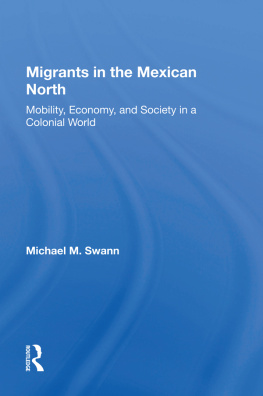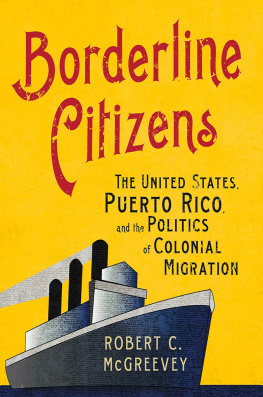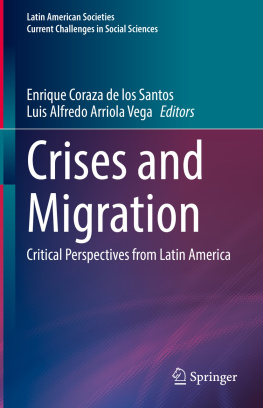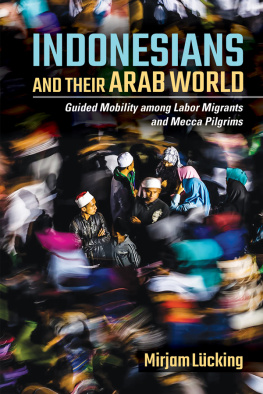MIGRANTS IN THE MEXICAN NORTH
Dellplain Latin American Studies
P UBLISHED IN C OOPERATION WITH THE D EPARTMENT OF G EOGRAPHY S YRACUSE U NIVERSITY
Editor
David J. Robinson
Dellplain Latin American Studies
First published in 1989 by Westview Press
Published in 2021 by Routledge
605 Third Avenue, New York, NY 10017
2 Park Square, Milton Park, Abingdon, Oxon OX14 4RN
Routledge is an imprint of the Taylor & Francis Group, an informa business
Copyright 1989 by the Department of Geography, Syracuse University
All rights reserved. No part of this book may be reprinted or reproduced or utilised in any form or by any electronic, mechanical, or other means, now known or hereafter invented, including photocopying and recording, or in any information storage or retrieval system, without permission in writing from the publishers.
Notice:
Product or corporate names may be trademarks or registered trademarks, and are used only for identification and explanation without intent to infringe.
Library of Congress Cataloging-in-Publication Data
Swann, Michael M.
Migrants in the Mexican North: mobility, economy, and society in a colonial world/by Michael M. Swann.
p. cm. (Dellplain Latin American Studies: no. 24)
Includes bibliographical references.
ISBN 0-8133-7782-X
1. Migration, InternalMexicoHistory18th century. 2. MexicoPopulationHistory18th century. I. Title. II. Series.
HB1991.S93 1989
304.8721dc20
89-37520
CIP
ISBN 13: 978-0-3670-1322-6 (hbk)
ISBN 13: 978-0-3671-6309-9 (pbk)
DOI: 10.4324/9780429043086
Contents
2 Provincia, Padrn, and Partidos
3 Demographic Hinterlands in the North
4 Vagabundos, Vecinos, and Viajeros
5 Mobility, Economy, and Society in a Colonial World
- 2 Provincia, Padrn, and Partidos
- 3 Demographic Hinterlands in the North
- 4 Vagabundos, Vecinos, and Viajeros
- 5 Mobility, Economy, and Society in a Colonial World
Guide
Tables
2.1 Individual Jurisdictions Providing Census Information on Population Origins
2.2 Basic Ecological and Economic Characteristics of Jurisdictions
A Mining
B Farming
C Mixed
2.3 Basic Characteristics of Household Heads in Jurisdictions
A Mining
B Famiing
C Mixed
3.1 Occupational Differences in Average Migration Distances: All Jurisdictions Combined
4.1 Characteristics of Household Heads in Combined Jurisdictions: Locals and Migrants
4.2 Characteristics of Household Heads in Mining Jurisdictions: Locals and Migrants
4.3 Characteristics of Household Heads in Farming Jurisdictions: Locals and Migrants
4.4 Characteristics of Household Heads in Mixed Jurisdictions: Locals and Migrants
4.5 Average Migration Distances for Socio-economic and Demographic Groups: Combined Jurisdictions
4.6 Average Migration Distances for Socio-economic and Demographic Groups: Individual Jurisdictions
A Mining
B Farming
C Mixed
Figures
2.1 Southern Nueva Vizcaya in the Mid-Eighteenth Century: The Human Landscape
2.2 Population Distribution and Change: Southern Nueva Vizcaya, 17651779
2.3 Portion of a Census Executed in Cusihuiriachic, July 1, 1778
2.4 Jurisdictional Centers Included in the Study
2.5 Racial Composition and Civil Status Patterns of Household Heads in Jurisdictions
3.1 Some Basic Variations in Origin Patterns and Migration Fields
3.2 Migration Fields: Mining Jurisdictions
3.3 Distribution of Jurisdictions According to Complexity and Proximity in Migration Fields
3.4 Distribution of Jurisdictions According to Grouping and Localization in Migration Fields
3.5 Migration Fields: Farming Jurisdictions
3.6 Migration Fields: Mixed Jurisdictions
3.7 Average Migration Distances for Non-native Household Heads in Different Age Categories
3.8 Ratios of Average Migration Distances between Younger and Older Non-native Household Heads
4.1 Migration and Upward Mobility: Four Spaniards in the Mexican North
Preface and Acknowledgments
Latin America has always been a land of fragmented frontiers and booming cities, of ecological catastrophes and cultural conflict. From the pre-Columbian past to the post-industrial present, the successive invasion and expansion of empires has produced a turbulent human geography marked by mobility and transformed by migration. This unsettled distribution of people experienced its most profound rearrangement, however, during the colonial period, the three centuries that followed the Hispanic Conquest. Throughout this era, people were pushed and pulled from their native lands as labor intensive industries and commercial economies were established to serve Europe.
These early population movements revealed much about the Hispanic Empire and its inhabitants. For many Indian laborers, migration was made without choice; their forced relocation to the mines and plantations clearly reflected the purpose and priorities of the colonial system. Among others who moved freely, migration was both an important adaptive strategy and a simple but telling expression of a persons needs, goals, and values. Royal bureaucrats, skilled craftsmen, and agrarian laborers all used migration to gain access to opportunities. The personal cost of this mobility was high, often amounting to a sudden and irrevocable break with a place-specific past. Whereas it took centuries of miscegenation to blur the once sharp distinctions of the caste system, a single migration could destroy the ties to place and community that took generations to form. Yet, little is known of the most fundamental processes and patterns of migration that evolved as the Hispanic colonies were drawn into the global economy.
This monograph attempts to uncover some of the basic patterns and relationships that characterized early free migration in northern Mexico, one of the most dynamic and diverse regions of Hispanic America. Here, midway between Mexico City and Santa F, where the rugged Sierra Madre separated the rich Pacific coastal plain from the vast and arid central plateau, population growth and migration were common. During the late eighteenth century, as the regional mining and ranching economy thrived under the Bourbon reforms, mobility was the rule. Typically, an explosion of growth in a young, isolated mining center occurred simultaneously with the collapse of another older silver town nearby. As a consequence, the market for agricultural products and other goods and services shifted within the region and the volume, direction, and rhythm of human migration also changed. Eventually, a complex, late-colonial network of flows developed between town and countryside, among the villages of the North, and between different localized economies.
This web of human movement is examined here from two distinct perspectives. First, the patterns of in-migration that developed around different northern settlements are reconstructed and examined. By analyzing and comparing these patterns for a number of destinations with different ecological and economic characteristics, the relationships between a towns developmental history and its ability to draw migrants are made clear.
Second, the selective nature of migration, as displayed in the socioeconomic and demographic characteristics of migrants, is explored in some detail. Profiles of migrants are reconstructed and personal migration histories are studied in order to understand how the propensity toward mobility varied among people. This dual focus on the migrants themselves as well as on their patterns of movement provides a basis for conclusions that link eighteenth-century social change with the transformation of the colonial economy and the onset of urbanization.










